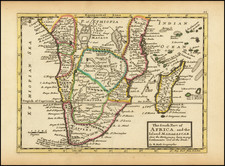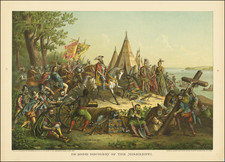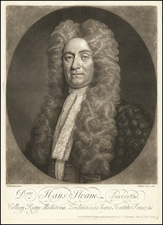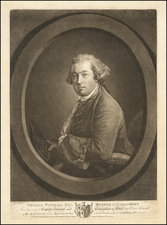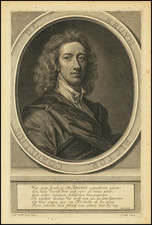A Hottentot Native of South Africa
Scarce image of an indigenous Hottentot, in an indigenous costume.
The image appeared in Happel's Thesaurus Exoticorum, pubished in Hamburg in 1688. The text below reads:
Situated falsely below or behind Moorland, right on the borders of the Kingdom of Angola, begins the Kaffrarian Coast, which extends along the seashore down to the Cape of Good Hope and from there again up towards the northeast to the coast of Zanguebar. This stretch of land is inhabited everywhere by wild and barbaric peoples, one of whom is depicted here. Due to their peculiar pronunciation, they are often called the Hottentots. This nation is very bestial and is divided into many tribes or hordes. Some of these are ruled by kings, while others are governed by chiefs, similar to the Asian Tartars. The most prominent, known to the Europeans at that time, are the Gorachaus, Goringhais, Rochaker, large and small Kariguriker, Hofaer, Kaiusgus, Koboner, Sonker, Namaker, Heusaker, Brigoudiner, and Haukouker. The first eight reside near the aforementioned Cape, and the furthest are not more than 50 miles away. Throughout this entire district, one does not find a city or village, for the Hottentots live everywhere in huts, like the Arabs. However, at the outermost Cape, the Dutch have built a fort and some inhabited places and have cultivated much of the surrounding land. But let's look more closely.
The Nature of the Hottentots.
Regarding the nature, the manner, and the physical appearance of the Hottentots who live near the Cape of Good Hope: most of them are of medium height, thin and unsightly in body shape, and are of a yellowish color, like the Mulattos or the yellowish Japanese. However, those who stay near the Meat Bay are somewhat shorter than the people in Holland and are reddish-brown, some more than others.
Eberhard Werner Happel (1647–1690) was a German author of scientific and historical works. The son of a reformist Lutheran minister, he studied law, mathematics, and natural sciences in Marburg, Germany, from the 1660s to 1680s, though due to financial issues he never finished his formal education. He also tutored aristocratic families in Hessen and Hamburg during this time. Around 1680 he devoted himself to writing, publishing several works of historical fiction. He also published several historical and scientific almanacs, the most famous of which was Historia Moderna Europae, which covered recent European political history and included detailed maps and engravings. His most famous scientific work was Gröste Denkwürdigkeiten der Welt: Oder, So genannte “relationes curiosae”, which contained one of the most important early discussions of oceanographic phenomena. In later years Happel continued to be a successful and widely read author. He died in Hamburg at age 42, survived by his wife, Margarita, and four children.









